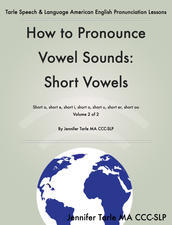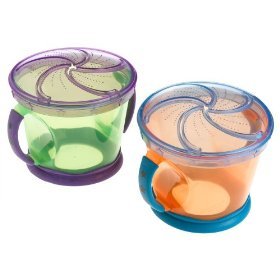Jennifer Tarle's Blog, page 114
August 30, 2016
Word Stress: Phrasal Verbs
1. verb + adverb
2. verb + preposition
For instance, “cut” means to make an incision with a sharp object. “Off” means to remove. When used as a verb phrase “cut off” means stopping or interrupting something.
Stress is important in pronouncing phrasal verbs, as it distinguishes it as a new phrase, not two separate words. To say a phrasal verb correctly, link the words, basically, say the words together as if they are one word. Do not pause between the words. The word stress falls on word number two. That means that the stressed word is pronounced louder, higher in pitch, and with a longer vowel.
Learn more about word stress with this free class.
August 25, 2016
Diagraphs: Two Letters that Make One Sound
A digraph is term used to describe two or more letters that make one sound. Here are some common digraphs:
CH: pronounced “ch” in cheese, inches, church
SH: pronounced “sh” in shoe, mission, wish
WH: pronounced “w” in when, where, why
TH: pronounced “th” in this, weather, with
PH: pronounced “f” in photo, hyphen, autograph
TCH: pronounced “ch: in itch, catch, stretch
WR: pronounced “r”: write, wrong, wrench
August 22, 2016
Difference between RECORDED and REPORTED
Today’s question is from a YouTube subscriber: “What is the difference between recorded and reported? People can’t understand me.”
Great question. Pay attention to the three syllables in each word.
RECORDED: re-core-did
REPORTED: re-pore-did
August 20, 2016
Help your child talk: WAIT
I hear this often. “I know what my child talks but he won’t ask me for things.”
If you know what your child wants, WAIT for him to ask. Give him the opportunity and your undivided attention then WAIT. Count to ten, sing a song, go over the grocery list in your head… WAIT!
Children who are learning to use words need more time to formulate a thought. Most times, parents aren’t giving their child enough time to initiate or respond. Waiting sounds easy, but it is not.
When your child is reaching for her milk, you may say “use your words”. Great. But then, you say, “milk, milk, here is the milk, you want milk”. This is a great way to model language but it does not allow your child any time to make the request.
Instead, when you say “use your words”, WAIT. Count to ten, then provide help if needed. Give her extra time and WAIT!
August 19, 2016
ESL teachers: get your vowel sound teaching materials on iTunes
ESL teachers, improve your student’s English pronunciation today. Help your students achieve clearer and more effective speech using Tarle Speech pronunciation ebooks for American vowel sounds. Tarle Speech is pleased to announce that our sound packages are now available in two ebooks on the iTunes store.
Through these valuable guides, you will:
Learn how to teach each sound through clear instructions and close up video examples. Then use the practice files to guide your students to achieve mastery of each sound through intensive practice sections
These books include practice lessons developed by Jennifer Tarle M.A. CCC-SLP, a leading expert in ESL pronunciation. Each practice lesson includes simple, clear, written instructions, video close ups of each sound, video examples of words and sentences, and audio examples of words and sentences.
The Tarle Speech method of ESL pronunciation training will get the results that you need to become a more effective English communicator. Improve your student’s English pronunciation and be better understood today!
Try it. People will notice the difference!
Get your copies today:
How to Pronounce Vowel Sounds: Short Vowels: Short vowels: Short a, short e, short i, short o, short u, short er, short oo
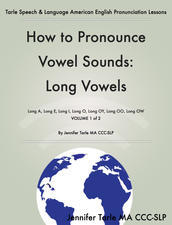
How to Pronounce Vowel Sounds: Long Vowels: Long A, Long E, Long I, Long O, Long OI, Long OO, Long OW
August 15, 2016
How to say Other
Take this quick ESL pronunciation speaking lesson to learn how to pronounce the word: OTHER. This word is confusing since it is not pronounced the way it is spelled. It is pronounced short u-th-short er.
Need more help, then buy a sound package with directions on how to say the sound, audio examples, video examples, and practice word and sentence lists.
Short u: http://www.tarlespeech.com/product/sh...
TH: http://www.tarlespeech.com/product/th...
Short er: http://www.tarlespeech.com/product/sh...
SUBSCRIBE: http://www.youtube.com/user/TarleSpeech
BLOG/SHOP: http://www.tarlespeech.com
FB: http://tinyurl.com/create.php
TWEET: https://twitter.com/tarlespeech
GOOLGE+: http://tinyurl.com/ol5x762
PODCAST: http://tinyurl.com/q82ph7c
IBOOKS: http://tinyurl.com/nfwe2sf
August 12, 2016
ESL teachers: get your consonant sound teaching materials on iTunes
ESL teachers, improve your student’s English pronunciation today. Help your students achieve clearer and more effective speech using Tarle Speech pronunciation ebooks for consonant sounds.
Through these valuable guides, you will:
Learn how to teach each sound through clear instructions and close up video examples. Then use the practice files to guide your students to
achieve mastery of each sound through intensive practice sections
These books include practice lessons developed by Jennifer Tarle M.A. CCC-SLP, a leading expert in ESL pronunciation. Each practice lesson includes simple, clear, written instructions, video close ups of each sound, video examples of words and sentences, and audio examples of words and sentences.
Get your copy today:
Volume 1: How to Pronounce Consonant Sounds: Nasals, Glides, & Liquids
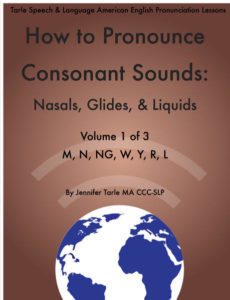
Volume 2: How to Pronounce Consonant Sounds: Stops and Affricates
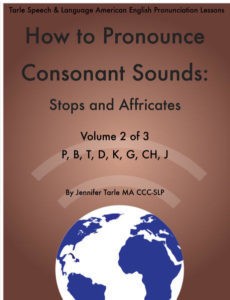
Volume 3: How to Pronounce Consonant Sounds: Continuants
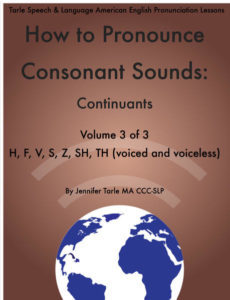
Repetition
Help your child learn through repetition. Say a word over and over. Say it slowly and clearly. Use the word in a sentence. Say it again. Say it until you are blue in the face. Repeat, repeat, repeat.
Children need a lot of repetition to learn. A child who is a late talker probably needs more repetition.
Here is an example of how to repeat during snack time:
Milk and cookies!
This milk is good.
Mmmm, cold milk.
Jack is drinking milk.
Will has milk.
Mommy has milk.
Milk!
I like milk.
Maybe your child will join in and say “milk”!
August 1, 2016
How to say Pearl & Plural
Take this quick ESL pronunciation speaking lesson to learn how to pronounce the words: PEARL and PLURAL. Improve your speaking today with this short video lesson.
Need more help, then buy a sound package with directions on how to say the sound, audio examples, video examples, and practice word and sentence lists.
PEARL-P, short er, L
PLURAL-PL, short er, L
P: http://www.tarlespeech.com/product/th...
PL: http://www.tarlespeech.com/product/l-...
L: http://www.tarlespeech.com/product/th...
short er: http://www.tarlespeech.com/product/sh...
R movement: http://www.tarlespeech.com/product/r-...
SUBSCRIBE: http://www.youtube.com/user/TarleSpeech
BLOG/SHOP: http://www.tarlespeech.com
FB: http://tinyurl.com/create.php
TWEET: https://twitter.com/tarlespeech
GOOLGE+: http://tinyurl.com/ol5x762
PODCAST: http://tinyurl.com/q82ph7c
IBOOKS: http://tinyurl.com/nfwe2sf
July 29, 2016
Self feeding tip…snack catchers
Parents often ask me “how do I keep my child from putting so much cereal in her mouth?” My answer: “snack catchers!”
These little cups keep bite sized treats from spilling. The cover has flaps that little fingers can squeeze into to get the goodies. Not only does it keep food from falling on the floor, but it limits how many pieces of a snack your child can get.
These little cups keep bite sized treats from spilling. The cover has flaps that little fingers can squeeze into to get the goodies. Not only does it keep food from falling on the floor, but it limits how many pieces of a snack your child can get.

